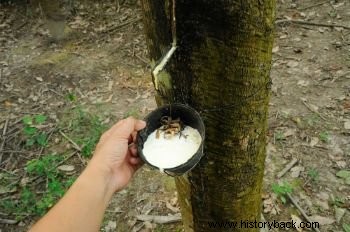The Rubber Cycle corresponds to the period in Brazilian history in which the extraction and commercialization of latex for rubber production were basic activities of the economy.
In fact, they occurred in the central region of the Amazon forest, between 1879 and 1912, reinvigorating for a short time between 1942 and 1945.
In this period, known as the “Amazonian Belle Époque” which runs from 1890 to 1920, cities such as Manaus, Porto Velho and Belém became the most developed Brazilian capitals, with electricity, piped water and sewage systems, museums and cinemas built. under European influence.
However, the two periods of “rubber cycles” ended suddenly, which was aggravated by the lack of public policies for the development of the region.
Main Causes and Consequences
The demand caused by the Industrial Revolution made natural rubber a highly valued product, especially after the advent of the vulcanization process, an industrial treatment that eliminates coagulation impurities, making rubber a good material to be used in car tires, motorcycles and bicycles, as well as in the manufacture of belts, hoses, shoe soles, etc.
 Latex Extraction
Latex Extraction
During this period, around 40% of all Brazilian exports came from the Amazon, paid in pound sterling (£), the currency of the United Kingdom.
As a consequence of this “boom ”, many riverside towns and villages emerged and the cities that already existed prospered and grew, developing from basic infrastructure such as schools and hospitals to the most sumptuous, such as luxury hotels and theaters.
In addition to socio-economic development, hundreds of thousands of workers, mainly from the northeast, migrated to the region, partially solving the population problem.
Historical Context
In 1495, Christopher Columbus already announced Brazilian rubber; however, the colony's regional economy for the Amazon was restricted to the extraction of “Drogas do Sertão”.
It was not until 1743, when French naturalist Charles Marie la Condamine described the process of extracting and manufacturing latex gum, that rubber aroused commercial interest.
So, in 1763, French chemists discover how to dissolve rubber with turpentine and ether, and in 1770, Joseph Priestley creates the rubber to erase graphite.
From the beginning of the 19th century, the exploitation of rubber was already a reality:in 1803, in the city of Paris, the first factory for rubber products was founded; in 1823, the Englishman Thomas Hancock created the elastic and, in 1839, Charles Goodyear developed the vulcanization process, making latex a viable material for industrial use.
First Rubber Cycle
In 1877, more than 70 thousand rubber seeds from Pará were smuggled to England, in a scandalous case of biopiracy. This fact marks the beginning of this first cycle.
In 1903, the Brazilian government, in negotiation with the Bolivian government, officially acquired control of the State of Acre, through the payment of 2 million pounds sterling, the delivery of territories in Mato Grosso and the construction of a railroad to transport the products. from the Amazon.
Thus, the works for the construction of the railroad began in 1907 and were concluded in 1912, solving the problem of navigation of the Mamoré River, with more than twenty waterfalls.
However, the Madeira-Mamoré railway went into decline in the 1930s and was deactivated in 1972.
In 1910, competition for Hevea brasiliensis begins. planted in Asia, using those seeds smuggled decades earlier and producing at much lower costs than native forests in Brazil.
This causes a sudden drop in the price of latex, making commercial exploitation of Amazonian rubber impossible. As a result, Brazilian rubber production goes into crisis, paralyzing the economy in the producing regions.
Second Rubber Cycle
In turn, the “second Rubber Cycle” took place between 1942 and 1945, during the context of the Second World War. In 1941, the Brazilian government made an agreement with the US government to extract latex in the Amazon.
Thus, when the Japanese invaded Malaysia in 1942, taking control of the rubber plantations, the USA, through its War Department, transferred more than 100 million dollars to Brazil in exchange for articles necessary for national defense, among them, the rubber.
The commotion was so great that it was necessary to create a Special Service for the Mobilization of Workers for the Amazon, instituted in 1943 for the compulsory enlistment, especially of Northeasterners who suffered from the drought. This event became known as the “Battle of Rubber”, which mobilized more than 100 thousand “Rubber Soldiers”.
Finally, the synthetic rubber produced after the Second World War, destroys any commercial pretension of Amazonian rubber, which will wither until 1960. Currently, São Paulo is the largest Brazilian producer of natural rubber.
Fun fact:Did you know?
From the rubber tree (Hevea brasiliensis ) a viscous, white liquid called latex is extracted, which undergoes spontaneous coagulation in contact with air, forming the polymer known as rubber.
See also:
- Acrean Revolution
- Gold Cycle
- Brazilian Business Cycles
